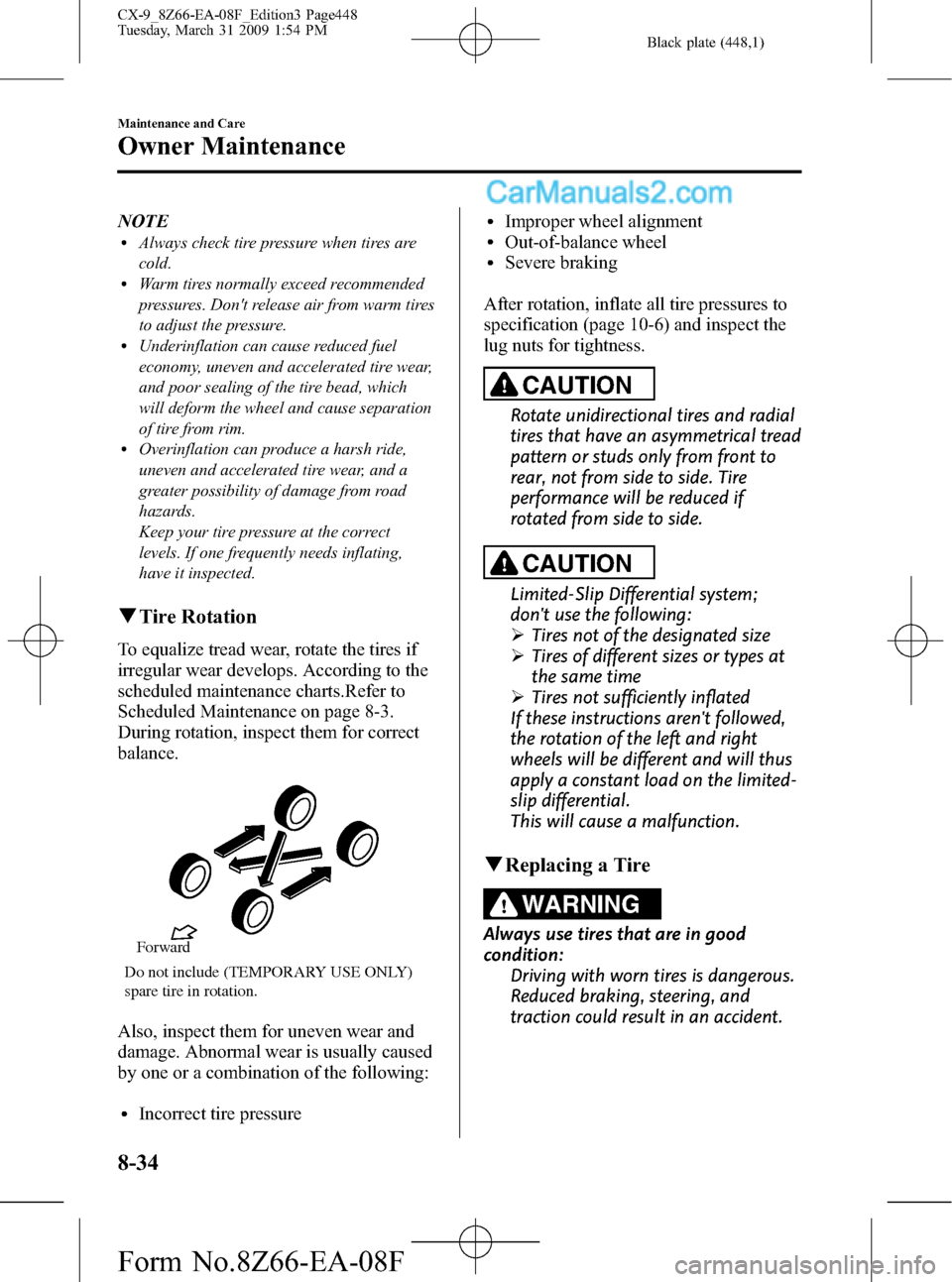lug pattern MAZDA MODEL CX-9 2009 Owners Manual (in English)
[x] Cancel search | Manufacturer: MAZDA, Model Year: 2009, Model line: MODEL CX-9, Model: MAZDA MODEL CX-9 2009Pages: 538, PDF Size: 12.18 MB
Page 448 of 538

Black plate (448,1)
NOTElAlways check tire pressure when tires are
cold.
lWarm tires normally exceed recommended
pressures. Don't release air from warm tires
to adjust the pressure.
lUnderinflation can cause reduced fuel
economy, uneven and accelerated tire wear,
and poor sealing of the tire bead, which
will deform the wheel and cause separation
of tire from rim.
lOverinflation can produce a harsh ride,
uneven and accelerated tire wear, and a
greater possibility of damage from road
hazards.
Keep your tire pressure at the correct
levels. If one frequently needs inflating,
have it inspected.
qTire Rotation
To equalize tread wear, rotate the tires if
irregular wear develops. According to the
scheduled maintenance charts.Refer to
Scheduled Maintenance on page 8-3.
During rotation, inspect them for correct
balance.
Do not include (TEMPORARY USE ONLY)
spare tire in rotation.Forward
Also, inspect them for uneven wear and
damage. Abnormal wear is usually caused
by one or a combination of the following:
lIncorrect tire pressure
lImproper wheel alignmentlOut-of-balance wheellSevere braking
After rotation, inflate all tire pressures to
specification (page 10-6) and inspect the
lug nuts for tightness.
CAUTION
Rotate unidirectional tires and radial
tires that have an asymmetrical tread
pattern or studs only from front to
rear, not from side to side. Tire
performance will be reduced if
rotated from side to side.
CAUTION
Limited-Slip Differential system;
don't use the following:
ØTires not of the designated size
ØTires of different sizes or types at
the same time
ØTires not sufficiently inflated
If these instructions aren't followed,
the rotation of the left and right
wheels will be different and will thus
apply a constant load on the limited-
slip differential.
This will cause a malfunction.
qReplacing a Tire
WARNING
Always use tires that are in good
condition:
Driving with worn tires is dangerous.
Reduced braking, steering, and
traction could result in an accident.
8-34
Maintenance and Care
Owner Maintenance
CX-9_8Z66-EA-08F_Edition3 Page448
Tuesday, March 31 2009 1:54 PM
Form No.8Z66-EA-08F
Page 507 of 538

Black plate (507,1)
Tire Maintenance
Improper or inadequate vehicle maintenance can cause tires to wear abnormally. Here are
some important maintenance points:
qTire Inflation Pressure
Inspect all tire pressure monthly (including the spare) when the tires are cold. Maintain
recommended pressures for the best ride, top handling, and minimum tire wear. Use the
pressures specified on the vehicle tire information placard or tire label for optimum service.
qTire Rotation
To equalize tread wear, rotate the tires every 12,000 km (7,500 miles) or sooner if irregular
wear develops. During rotation, inspect them for correct balance.
Do not include (TEMPORARY USE ONLY)
spare tire in rotation.Forward
Inspect the tires for uneven wear and damage. Abnormal wear is usually caused by one or a
combination of the following:
lIncorrect tire pressurelImproper wheel alignmentlOut-of-balance wheellSevere braking
After rotation, inflate all tire pressures to specification (page 10-6) and inspect the lug nuts
for tightness.
CAUTION
Rotate unidirectional tires and radial tires that have an asymmetrical tread pattern
or studs only from front to rear, not from side to side. Tire performance will be
weakened if rotated from side to side.
Customer Information and Reporting Safety Defects
Tire Information (except Canada)
9-35
CX-9_8Z66-EA-08F_Edition3 Page507
Tuesday, March 31 2009 1:55 PM
Form No.8Z66-EA-08F